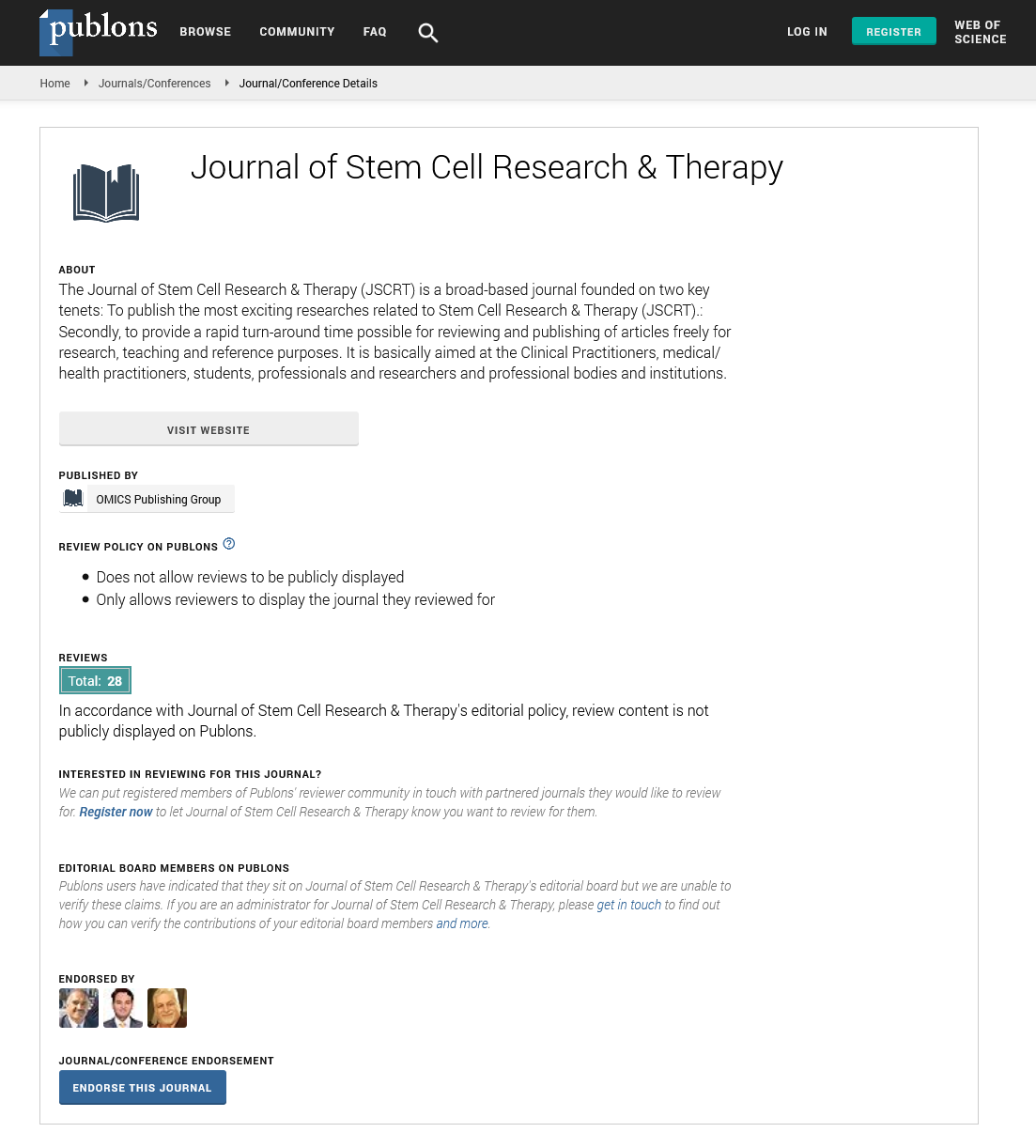Indexed In
- Open J Gate
- Genamics JournalSeek
- Academic Keys
- JournalTOCs
- China National Knowledge Infrastructure (CNKI)
- Ulrich's Periodicals Directory
- RefSeek
- Hamdard University
- EBSCO A-Z
- Directory of Abstract Indexing for Journals
- OCLC- WorldCat
- Publons
- Geneva Foundation for Medical Education and Research
- Euro Pub
- Google Scholar
Useful Links
Share This Page
Journal Flyer

Open Access Journals
- Agri and Aquaculture
- Biochemistry
- Bioinformatics & Systems Biology
- Business & Management
- Chemistry
- Clinical Sciences
- Engineering
- Food & Nutrition
- General Science
- Genetics & Molecular Biology
- Immunology & Microbiology
- Medical Sciences
- Neuroscience & Psychology
- Nursing & Health Care
- Pharmaceutical Sciences
Short Communication - (2022) Volume 12, Issue 6
Transcription Factors of LSCs in Acute Myeloid Leukaemia.
Shiny Libeta*Received: 31-May-2022, Manuscript No. JSCRT-22-17273; Editor assigned: 03-Jun-2022, Pre QC No. JSCRT-22-17273(PQ); Reviewed: 21-Jun-2022, QC No. JSCRT-22-17273; Revised: 29-Jun-2022, Manuscript No. JSCRT-22-17273(R); Published: 07-Jul-2022, DOI: 10.35248/2157-7633.22.12.539
Description
Acute Myeloid Leukaemia (AML) is a heterogeneous disease with a high mortality rate that is defined by morphology and chromosome abnormalities. Leukemia Stem Cells (LSCs) were thought to be the cause of chemotherapeutic treatment resistance and disease relapse in AML and played significant roles in the development and progression of leukaemia. Membrane markers such CD34, CD38, CD123, TIM3, CD25, CD32, and CD96 were used to identify and target LSCs. Additionally, the therapeutic targets for eliminating LSCs included transcription factors such Histone Deacetylases (HDACs), NF-B, HIF-1, and -catenin. Telomerase, microRNAs, intracellular Reactive Oxygen Species (ROS), and membrane markers and transcription factors were shown to be new targets for eliminating LSCs in AML.
Recently, a number of transcription factors that influence LSC activity and functionality in AML have been discovered. LSCs were significantly linked to refractory AML, multi-drug resistance, and relapse, as was previously described [1]. The primary mechanism for LSC survival and continuing evolution during and after chemotherapy is the alternative p53- inactivating. Furthermore, histone deacetylases might control the function of p53 (HDACs). As a result, the HDACs protein modulators could be used to regulate p53 activity, improve chemotherapy response, and target LSCs. HIF-1 (hypoxiainducible factor-1) has a key role in controlling low oxygen levels in AML. HSCs and LSCs in AML were able to replenish themselves. According to Bonnet and his coworkers, HIF-1 or HIF-2 may serve as prospective therapeutic targets for eliminating LSCs in AML because they are essential for the survival of LSCs [2].
NF-B has a crucial role in transcriptional regulation of cell proliferation, differentiation, and survival. While NF-B is greatly overexpressed in LSCs, it is markedly underexpressed in HSCs. As a result, NF-B might discriminate between HSCs and LSCs, making it a viable therapeutic target for the targeted destruction of LSCs while protecting HSCs. A NF-B inhibitor called Dimethylaminoparthenolide (DMAPT) is currently undergoing clinical trials in the UK to treat acute Lymphoblastic Leukaemia (ALL), Chronic Lymphocytic Leukaemia (CLL), and AML by selectively eliminating LSCs. Because DMAMCL (ACT001) restrained NF-B activity, LSCs were destroyed. Australia hosted a clinical trial for ACT001 [3-4].
β-catenin is a key molecule of Wnt/β-catenin signaling pathway which is essential for tumor occurrence, LSC self-renewal, recurrence, development and drug resistance. The Wnt/β- catenin was active in human LSCs and in HSCs while β-catenin was needless for the self-renew of adult HSCs. Meanwhile, pharmacological inhibition of β-catenin reduced LSC function and significantly impaired the growth of human MLL leukemic cells. Therefore, all these transcription factors might be considered to be potential targets for selectively ablating LSCs [5].
Conclusion
LSCs in AML were considered to be the foundation of chemotherapeutic drug resistance and disease degeneration. LSCs are the subpopulation cells featured with membrane markers like CD34, CD38, CD123, TIM3, CD25, CD32 and CD96. In addition, the transcription factors were also therapeutic targets in eliminating LSCs, such as HDAC, NF-κB, HIF-1α and β-catenin. Besides membrane markers and transcription factors, intracellular ROS, telomerase and microRNAs were recognized to be new targets for ablating LSCs in AML. Identification of the exact features of LSCs will significantly prompt the discovery of potential agents that can selectively destroy LSCs in AML, which would greatly progress the response to drug resistant and refractory/relapsed AML.
REFERENCES
- Ley TJ, Mardis ER, Ding L, Fulton B, McLellan MD, Chen K. DNA sequencing of a cytogenetically normal acute myeloid leukaemia genome. Nature. 2008;456(7218):66-72.
- Hou HA, Tien HF. Genomic landscape in acute myeloid leukemia and its implications in risk classification and targeted therapies. J Biomed Sci. 2020;27(1):1-3.
- Ahmadmehrabi K, Haque AR, Aleem A, Griffiths EA, Roloff GW. Targeted therapies for the evolving molecular landscape of acute myeloid leukemia. Cancers. 2021;13(18):4646.
- Grimwade D, Ivey A, Huntly BJ. Molecular landscape of acute myeloid leukemia in younger adults and its clinical relevance. Blood, The Journal of the American Society of Hematology. 2016;127(1):29-41.
- Mullighan CG. The genomic landscape of acute lymphoblastic leukemia in children and young adults. Hematology Am Soc Hematol Educ Program. 2014;2014(1):174-180.
Citation: Libeta S (2022) The Transcription Factors of LSCs in Acute Myeloid Leukaemia. J Stem Cell Res Ther. 12:539.
Copyright: © 2022 Libeta S. This is an open-access article distributed under the terms of the Creative Commons Attribution License, which permits unrestricted use, distribution, and reproduction in any medium, provided the original author and source are credited.

